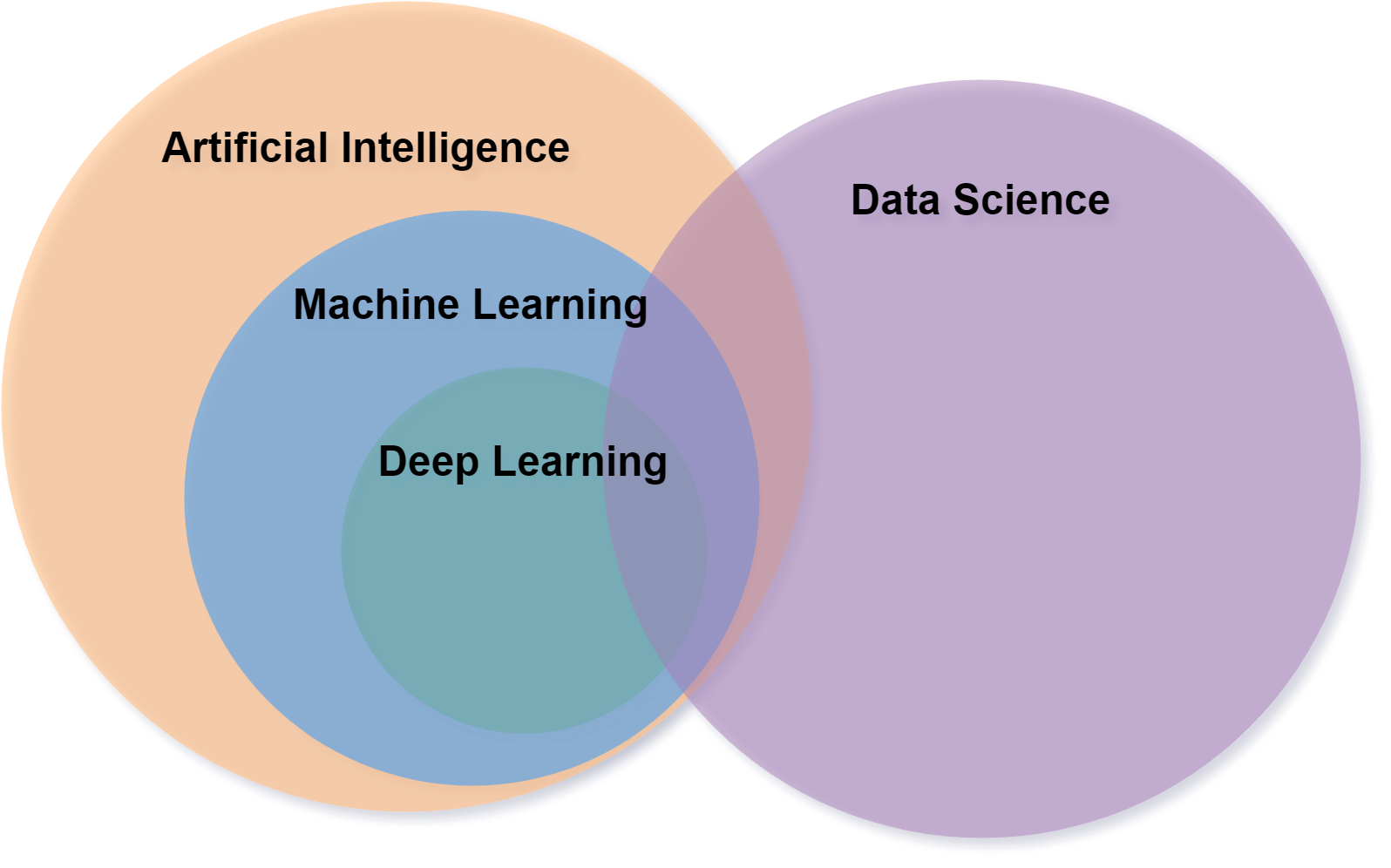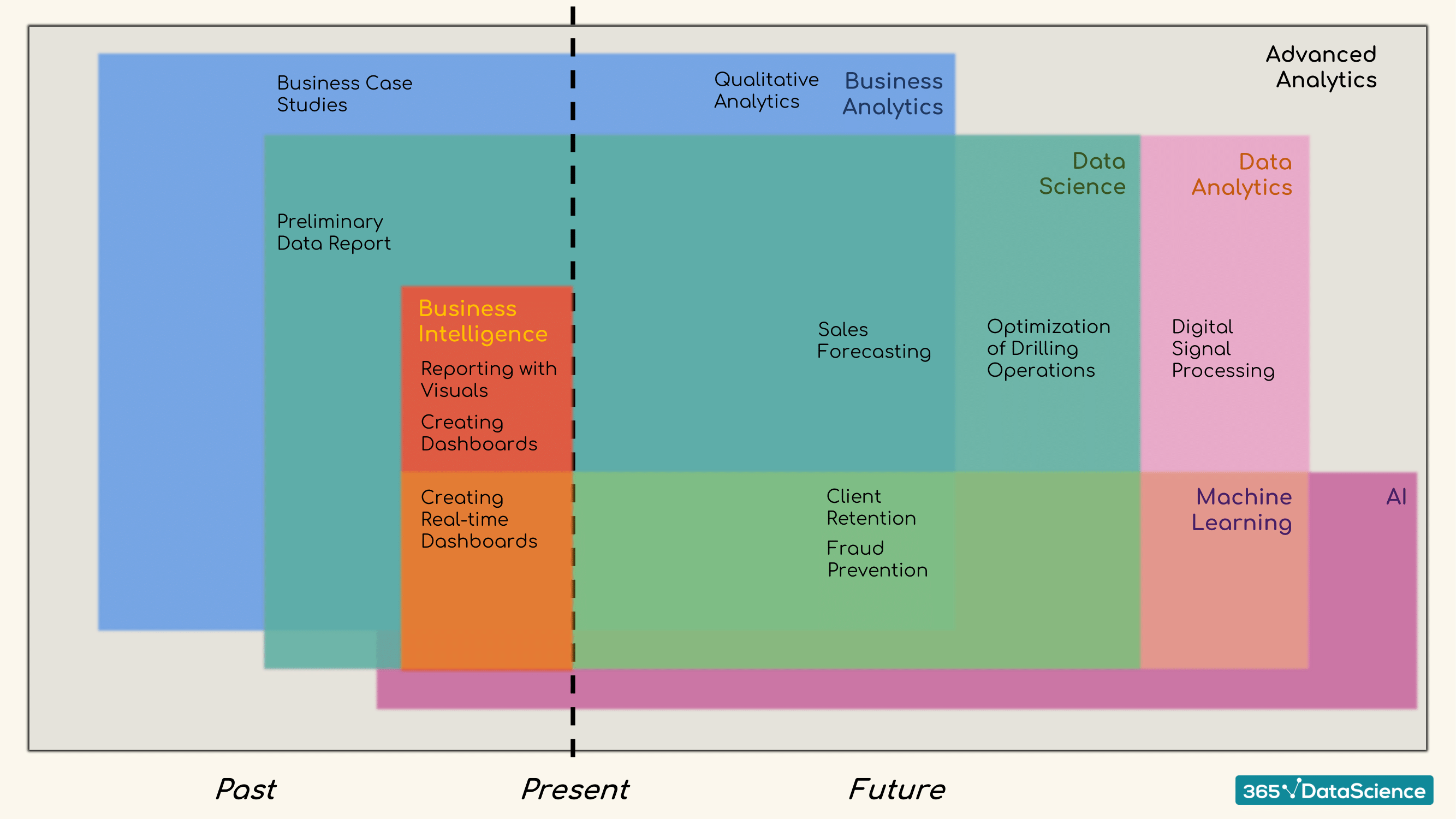Introduction to Intelligence
Fields


Intelligence
Intelligence is the ability to:
acquire and apply knowledge and skills
learn from experience
recognize and solve problems
Artificial Intelligence
Artificial Intelligence is the science and engineering behind the making of intelligent machines and computer programs for complex problem solving, such as visual perception, speech recognition, decision-making, and language translation.
Machine Learning
Machine Learning is the branch of Artificial Intelligence which focuses on the use of data and algorithms to improve automatically through experience in order to solve problems.
Deep Learning
Deep Learning is a subset of Machine Learning that uses programmable neural networks to learn and solve complex problems.
Data Science
Data Science is an interdisciplinary field that uses scientific methods, processes, algorithms and systems to extract knowledge and insights from noisy, structured and unstructured data, and apply knowledge and actionable insights from data across a broad range of application domains.
Categorization of Systems
| Humanly | Rationally | |
|---|---|---|
| Thinking | Thinking humanly — cognitive modeling. Systems should solve problems the same way humans do. | Thinking rationally — the use of logic. Need to worry about modeling uncertainty and dealing with complexity. |
| Acting | Acting humanly — the Turing Test approach. | Acting rationally — the study of rational agents: agents that maximize the expected value of their performance measure given what they currently know. |
Rational Systems
Rational Systems are ones that:
Think Rationally
Use logic to achieve goals via logical inferencing
Hard to represent informal knowledge
Not all problems solvable in this manner (e.g. uncertainty)
Behave Rationally
Amenable to computation
More general than inferencing (but can use inferencing)
Actions taken to achieve a goal are not necessarily "correct", but accomplish task at hand
Intelligent Agents
Agents
An Agent is something that senses its environment and acts on it.
Rational Agents
A Rational Agent is one that, for each perceived sequence of events, it does what is expected to maximize performance on the basis of perceptual history and built-in knowledge.
Types of Agents
Simple Reflex Agents
Agents that utilize simple table-lookup approach to solve problems and require fully observable environment.
Model-Based Reflex Agents
Agents that use state information to handle partially observable environments.
Goal-Based Agents
Agents that know the end goal and make decisions according to desirable situations.
Simple Reflex Agents
Agents that can use a measure of success at a given state to help make decisions.
Simple Reflex Agents
Agents that can learn situations that affect performance and learn how to change to improve.
Environments
Fully Observable vs Partially Observable
In a fully observable environment, an agent can sense or access the complete state of the environment that are relevant to the choice of action at each point of time.
In a partially observable environment, an agent can only sense or access part of the state of the environment at each point of time. This may be because of noisy or inaccurate sensors, or because parts of the state are simply missing.
Deterministic vs Stochastic
In a deterministic environment, an agent's current state and selected action can completely determine the next state of the environment.
In a stochastic environment, it is difficult or impossible to determine the next state of the environment given the agent's current state and selected action. Stochastic environments tend to have randomness in nature.
Episodic vs Sequential
In an episodic environment, selection of the current action only depends on the current state, and not on any past actions.
In a sequential environment, selection of the current action may depend on past actions. At the same time, the current decision may affect future decisions.
Static vs Dynamic
Static environments remain unchanged while an agent is deliberating.
Dynamic environments may change while an agent is deliberating. In dynamic environments, an agent may need to keep observing the environment to detect changes at each action.
Discrete vs Continuous
A discrete environment has finite number of percepts and actions that can be performed within it.
A continuous environment may have infinite number of percepts or performable actions.
Single-Agent vs Multi-Agent
A single-agent environment has only one agent involved.
A multi-agent environment may have multiple agents involved.
Adaptive & Cooperative Algorithms
Adaptation
Adaptation is the ability to adjust to new or different situation, and to improve behavior.
Cooperation
Cooperation involves the sharing of responsibility between entities in a group in order to solve a joint problem and reach a common goal.
Sources of Problem Complexity
Multimodality
Lack of exact mathematical model
Non-differentiability
Combinatorial nature
Distributed nature
Types of Problems
Well-Structured Problems
Well-structured problems are problems for which the existing state and the desired state are clearly defined, and the methods to reach the desired state are fairly obvious.
Ill-Structured Problems
Ill-structured problems are problems in which the existing and desired states are unclear, and hence, methods of reaching the desired state cannot be found.
| Well-Structured | Moderately-Structured | Ill-Structured | |
|---|---|---|---|
| Goals | Well Defined | Usually Well Defined | Undefined |
| Beginning State | Well Defined | Well Defined | Well Defined |
| Actions | Well Defined | Many Possible Actions | Undefined |
| End State | Well Defined | Well Defined | Undefined |
| Constraints | Well Defined | Usually Well Defined | Usually Not Well Defined |
| Example | Starting a car | Fixing a car | Designing a car |
Optimization Methods
Exact Algorithms
Find the optimal solution
High computational cost
Approximate Algorithms
Find near-optimal solution
Low computational cost
Approximate Algorithms
Constructive Methods
Constructive methods involve starting from scratch and trying to build the complete solution by adding one component at a time.
Local Search Methods
Local search methods involve starting from an initial solution and iteratively trying to replace the current solution with a better one.
Problem Formulation
A search problem can be formulated by outlining the following components in the problem:
State
The state of the problem is a complete or partial configuration of the agent's current state.
Initial State
Initial state is the state in which the agent begins the search.
Goal
The goal of the problem is the state(s) that are desirable. Once a goal state is reached, the search terminates.
Actions
The actions are the different moves that the agent can perform at any state.
Cost
The cost of a state is an quantification of how far the current state is from the initial state.
Hard & Soft Computing
Hard Computing
Hard computing techniques work following binary logic based on only two values (0 or 1) on which modern computers are based.
Soft Computing
Soft computing techniques, based on fuzzy logic, are much closer to the way the human brain works by aggregating data to partial truths.
Crisp & Fuzzy Logic
Crisp Logic
Crisp logic involves boolean logic, i.e. true or false. Any statement is either true or false (1 or 0).
Fuzzy Logic
Fuzzy logic involves capturing the degree to which something is true, often as a real value between 0 and 1.
Intelligent Systems
Intelligent systems are artificial entities involving a mix of software and hardware which have a capacity to acquire and apply knowledge in an "intelligent" manner and have the capabilities of perception, reasoning, learning, and making inferences (or, decisions) from incomplete information.
Concepts of Approximation
| Concept | Property | Example |
|---|---|---|
| Ambiguity | The condition has several different possibilities and it is not determined which one is valid. | The machine response "may or may not" satisfy the specification. |
| Vagueness | The condition is not precisely (clearly) defined. | The machine response "may have" met the specification. |
| Generality | The condition may apply to many (finite or infinite) situations depending on the specific context. | The machien response is "x" times the specification. |
| Imprecision | Condition can assume a state within a clearly defined (crisp) tolerance interval. | The machine response is "within ±5%" of the specification. |
| Uncertainty | There is a degree of probability associated with occurrence of the condition. | There is a "90% probability" that the machine response meets the specification. |
| Fuzziness | The membership of the condition is not crisply defined (set boundary of the condition is not crisp). | The machine response is "close to" the specification. |
| Belief (Subjective Probability) | The level of belief on the condition (membership of a crisp or fuzzy set) is trhough knowledge and evidence. | It is believed at a level of 90% that the machine response meets the specification. |
| Plausibility | The plausibility of nonmembership fully complements the belief of membership (dual condition of belief). | It is plausible at a level of 95% that the machine response meets the specification. |